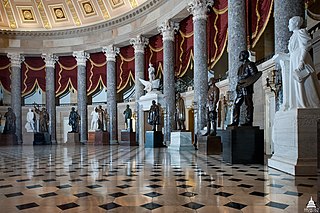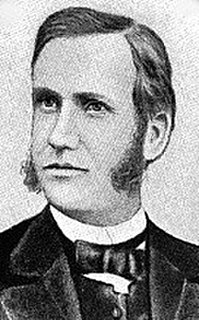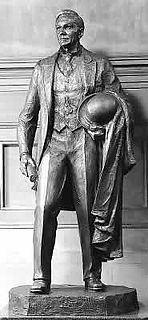
National Statuary Hall is a chamber in the United States Capitol devoted to sculptures of prominent Americans. The hall, also known as the Old Hall of the House, is a large, two-story, semicircular room with a second story gallery along the curved perimeter. It is located immediately south of the Rotunda. The meeting place of the U.S. House of Representatives for nearly 50 years (1807–1857), after a few years of disuse in 1864 it was repurposed as a statuary hall; this is when the National Statuary Hall Collection was established. By 1933 the collection had outgrown this single room, and a number of statues are placed elsewhere within the Capitol.

Marcus Whitman was an American physician. In 1836, Marcus Whitman led an overland party by wagon to the West. He and his wife, Narcissa, along with Reverend Henry Spalding and his wife, Eliza, and William Gray, founded a mission at present day Walla Walla, Washington in an effort to convert local Indians to Christianity. In the winter of 1842 Whitman returned east, returning the following summer with the first large wagon train across the Oregon Trail. The new settlers encroached on the Cayuse Indians living near the Whitman Mission and were unsuccessful in their efforts to Christianize the Tribe. Following the deaths of many nearby Cayuse from an outbreak of measles, some remaining Cayuse accused Whitman of murder, suggesting that he had administered poison and was a failed shaman. In retaliation, a group of Cayuse killed the Whitmans and twelve other settlers on November 30, 1847, an event that came to be known as the Whitman Massacre. Continuing warfare between settlers and Indians reduced the Cayuse numbers further.

Avard Tennyson Fairbanks was a 20th-century American sculptor. Over his eighty-year career, he sculpted over 100 public monuments and hundreds of artworks. Fairbanks is known for his religious-themed commissions for The Church of Jesus Christ of Latter-day Saints including the Three Witnesses, Tragedy of Winter Quarters, and several Angel Moroni sculptures on LDS temple spires. Additionally, Fairbanks sculpted over a dozen Abraham Lincoln-themed sculptures and busts among which the most well-known reside in the U.S. Supreme Court Building and Ford's Theatre Museum.
Barry Goldwater is a bronze sculpture depicting American politician and businessman of the same name by Deborah Copenhaver Fellows, installed at the United States Capitol's National Statuary Hall, in Washington, D.C., as part of the National Statuary Hall Collection. The statue was donated by the U.S. state of Arizona in 2015, and replaced a statue of John Campbell Greenway, which the state of Arizona gifted to the collection in 1930.

John Burke is a bronze sculpture depicting the American politician of the same name by Avard Fairbanks, installed at the United States Capitol's National Statuary Hall, in Washington, D.C., as part of the National Statuary Hall Collection. The statue was gifted by the U.S. state of North Dakota in 1963.

Brigham Young is a marble statue by Mahonri Young representing the Mormon religious leader of the same name, installed in the United States Capitol, in Washington D.C., as part of the National Statuary Hall Collection. It is one of two statues donated by the state of Utah, and is unusual in the collection in that Young is portrayed sitting down. The statue was unveiled by Alben William Barkley on June 1, 1950.

Jacob Collamer is a marble statue of Jacob Collamer by Preston Powers, installed in the United States Capitol, in Washington D.C., as part of the National Statuary Hall Collection. It is one of two statues donated by the state of Vermont. The statue was accepted in the collection by Alexander H. Stephens in 1881.

Helen Keller is a bronze sculpture depicting the American author and political activist of the same name by Edward Hlavka, installed in the United States Capitol Visitor Center's Emancipation Hall, in Washington, D.C., as part of the National Statuary Hall Collection. The statue was gifted by the U.S. state of Alabama in 2009, and replaced one depicting Jabez Lamar Monroe Curry, which had been donated in 1908.

John M. Clayton is a 1934 marble sculpture depicting the American lawyer and politician of the same name by Bryant Baker, installed in the United States Capitol, in Washington D.C., as part of the National Statuary Hall Collection. It is one of two statues donated by the state of Delaware The statue was accepted in the collection by Robert G. Houston on June 6, 1934.

George Clinton is an 1873 bronze sculpture depicting the American soldier and statesman of the same name by Henry Kirke Brown, installed in the United States Capitol, in Washington D.C., as part of the National Statuary Hall Collection. It is one of two statues donated by the U.S. state of New York. The statue is one of three by Brown in the Collection.
Huey Long is a 1941 bronze sculpture of Huey Long by Charles Keck, installed in the United States Capitol, in Washington, D.C., as part of the National Statuary Hall Collection. It is one of two statues donated by the state of Louisiana.

Andrew Jackson is a 1928 bronze sculpture of Andrew Jackson by Belle Kinney Scholz and Leopold Scholz, installed in the United States Capitol, in Washington D.C., as part of the National Statuary Hall Collection. It is one of two statues donated by the state of Tennessee. The statue was accepted in the collection by Senator Kenneth McKellar on April 16, 1928.

John James Ingalls is a 1905 marble sculpture of the politician of the same name by Charles Henry Niehaus, installed in the United States Capitol, in Washington D.C., as part of the National Statuary Hall Collection. It is one of two statues donated by the state of Kansas. The statue was accepted in the collection by Senator Arthur P. Gorman on January 21, 1905.

Esther Hobart Morris is a bronze sculpture depicting the first woman justice of the peace in the United States by Avard Fairbanks.

Oliver P. Morton is a 1900 marble statue of Oliver P. Morton by Charles Henry Niehaus installed in the United States Capitol, in Washington, D.C., as part of the National Statuary Hall Collection. It is one of two statues donated by the state of Indiana. The statue was accepted into the collection on April 14, 1900 by Indiana Senator Albert J. Beveridge.,

Julius Sterling Morton, also known as J. Sterling Morton, is a 1937 bronze sculpture of Julius Sterling Morton by Rudulph Evans, installed in the United States Capitol Visitor Center, in Washington, D.C., as part of the National Statuary Hall Collection. It is one of two statues donated by the state of Nebraska. The sculpture was accepted into the collection by Congressman Karl Stefan of Nebraska on April 27, 1937.
Francis Harrison Pierpont is a 1910 marble sculpture of Francis Harrison Pierpont by Franklin Simmons installed in the United States Capitol, in Washington, D.C., as part of the National Statuary Hall Collection. It is one of two statues donated by the state of West Virginia. The sculpture was unveiled by the Hon. Thomas Condit Miller, on April 27, 1937.
James Shields is an 1893 bronze sculpture of James Shields by Leonard Volk, installed in the United States Capitol, in Washington, D.C., as part of the National Statuary Hall Collection. It is one of two statues donated by the state of Illinois. The sculpture was unveiled by Senator Shelby Moore Cullom of Illinois on December 6, 1893.

John Campbell Greenway is a 1930 bronze statue of John Campbell Greenway by Gutzon Borglum, one version of which was installed in the United States Capitol, in Washington D.C., as part of the National Statuary Hall Collection. It was one of two statues donated by the state of Arizona. The sculpture was unveiled by Senator Henry Ashurst of Arizona on May 24, 1930.

In 2019, the U.S. state of Nebraska donated a bronze sculpture of Standing Bear by Benjamin Victor to the National Statuary Hall Collection, replacing one of William Jennings Bryan. The statue is installed in the United States Capitol's National Statuary Hall, in Washington, D.C.
















